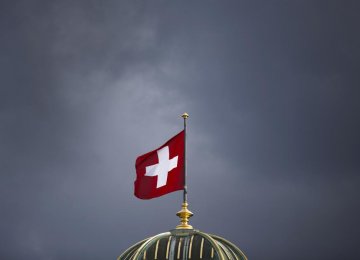Benchmark Azadi soared to a nine-month high on Saturday, as Tehran caught up with the rise in demand for bullion on Swiss National Bank’s decision to abandon its self-imposed peg of the Swiss franc versus the euro, which sent markets on a roller coaster ride on Friday.
The Switzerland’s central bank announced that it abandoned its policy (instituted back in 2011) of capping the currency at Sfr1.20 to the euro, and lowered the already negative interest rate on deposits from minus 0.25 percent to minus 0.75 percent. The SNB announcement came late Thursday evening.
The Swiss franc held steady in Tehran. “The Swiss franc isn’t traded much, most commercial activities are done via euros,” Jalil Motahari, owner of Darik Coin told the Financial Tribune, “the low demand for the franc slows its moves.” The Swiss currency traded at 34,300 rials on Saturday.
Azadi coin jumped 2.66 percent to 10,215,000 rials by 12:14 GMT on Saturday, breaking above the 10 million rial mark after four weeks of sideways movement. Azadi’s price briefly hit a nine-month high of 10,240,000 rials at 11:41 GMT.
Gold rose to a four-month high on Friday and was set to increase 4.5 percent for the week, its biggest weekly gain since August 2013, as investors sought safety from volatility in wider markets after the SNB decision, sending the Azadi soaring in Tehran.
Spot gold was up 1.4 percent at $1,280.21 an ounce at Friday’s close, after touching a four-month high of $1,282.13 earlier in the day, according to Bloomberg generic pricing. On Thursday, the metal rose 2.6 percent, the most in six weeks.
The SNB decision drove up demand for all precious metals. Spot silver rose 4.6 percent to $17.65 an ounce, after surging 5.5 percent to $17.81, the highest since Sept. 24. Platinum rose 0.6 percent to $1,261.80 and palladium slipped 1.6 percent to $751.00 an ounce.
Gold’s move higher came despite a dollar up 0.5 percent against a basket of major currencies, which would normally limit gains by the metal.
“The SNB announcement has added a bit of an extra juice to the gold story but from an interest rates and equity perspective it looks like there is a more solid foundation to its strength,” Deutsche Bank analyst Michael Lewis said.
Global shares steadied after Thursday’s volatility, while the yield on the benchmark 10-year US Treasury remained near its lowest since May 2013. Low yields reduce the cost of holding non-interest bearing gold.
Dealers assumed that the SNB had moved with the knowledge that the European Central Bank would take the plunge into full scale quantitative easing at its policy meeting on Jan. 22.
In a reflection of improving investor confidence, holdings of the SPDR Gold Trust, the world’s largest gold-backed exchange-traded fund, rose 1.35 percent to 717.15 tons on Thursday, Reuters wrote.
Physical demand, however, suffered a setback with the higher prices putting off buyers in Asia. Premiums on the Shanghai Gold Exchange fell to $1 to $2 an ounce over the global benchmark on Friday, from about $3 to $4 in the previous session, indicating softer demand.
Rial Holds Firm
Despite the shockwaves that rocked markets around the globe, the rial held relatively stable versus major currencies, and made minor gains against some.
The US dollar and the British pound edged down 0.06 and 0.19 percent respectively to 34,470 rials and 52,750 rials on Saturday. The euro slipped 0.56 to 40,750 rials 12:14 GMT, reflecting its weakness in the global arena.
Tehran’s currency movements were weak reflections of Friday and Thursday’s rocky markets. The US dollar and the euro gained a little ground against the Swiss franc on Friday, while the dollar hit new multi-year highs against the euro on expected ECB easing.
The euro suffered its biggest-ever one-day fall against the franc on Thursday, dropping more than 18 percent, after the SNB stunned markets.
As the euro touched an 11-year low against the dollar of $1.14595 on Friday, it fell to a seven-year trough versus the pound at 77.32 pence, leaving the single currency down 1.3 percent against sterling - its biggest daily fall in over a year, Reuters reported.
Volatility lingered and liquidity in franc trading was low as investors grappled with the SNB’s move, analysts said.
“Traders don’t know what the new equilibrium price is on the Swiss franc,” said Greg Anderson, global head of FX strategy at BMO Capital Markets in New York.
The dollar last traded at 0.85670 franc, up 2.1 percent on the day but still about 16 percent below where it was before the cap was scrapped. Thursday’s sharp acceleration in the franc resulted in the currency’s first weekly gain against the dollar since early December.
Sterling also sank to a three-year low against the Swiss franc, falling over 13 percent to 1.3244 francs per pound and last trading at 1.3530. Against the safe-haven yen, the dollar was up 1.3 percent at 117.640 yen. The dollar index, which measures the greenback against a basket of six major currencies, was last up 0.32 percent at 92.645 to notch its fifth straight week of gains.






